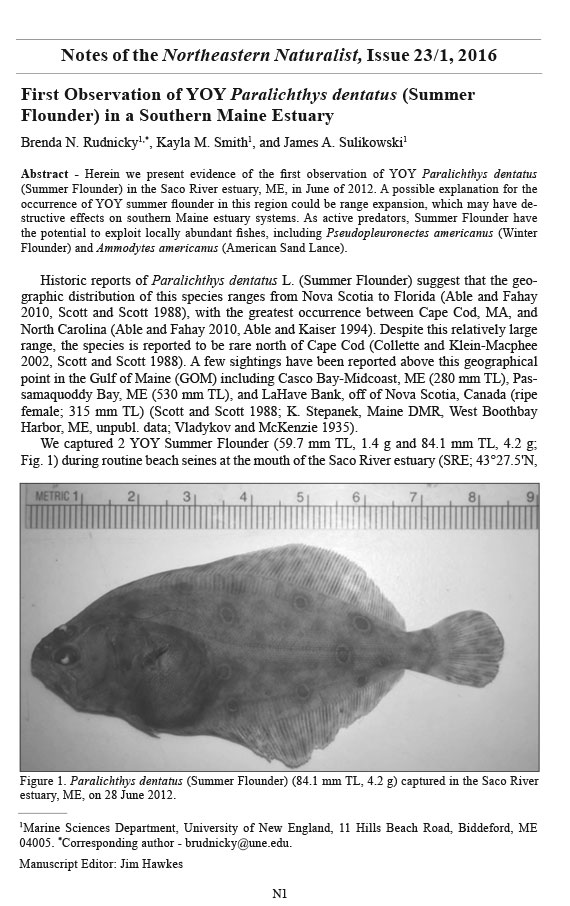First Observation of YOY Paralichthys dentatus (Summer
Flounder) in a Southern Maine Estuary
Brenda N. Rudnicky, Kayla M. Smith, and James A. Sulikowski
Northeastern Naturalist, Volume 23, Issue 1 (2016): N1–N3
Full-text pdf (Accessible only to subscribers. To subscribe click here.)

Access Journal Content
Open access browsing of table of contents and abstract pages. Full text pdfs available for download for subscribers.
Current Issue: Vol. 30 (3)

Check out NENA's latest Monograph:
Monograph 22









N1
2016 Northeastern Naturalist Notes Vol. 23, No. 1
B.N. Rudnicky, K.M. Smith, and J.A. Sulikowski
First Observation of YOY Paralichthys dentatus (Summer
Flounder) in a Southern Maine Estuary
Brenda N. Rudnicky1,*, Kayla M. Smith1, and James A. Sulikowski1
Abstract - Herein we present evidence of the first observation of YOY Paralichthys dentatus
(Summer Flounder) in the Saco River estuary, ME, in June of 2012. A possible explanation for the
occurrence of YOY summer flounder in this region could be range expansion, which may have destructive
effects on southern Maine estuary systems. As active predators, Summer Flounder have
the potential to exploit locally abundant fishes, including Pseudopleuronectes americanus (Winter
Flounder) and Ammodytes americanus (American Sand Lance).
Historic reports of Paralichthys dentatus L. (Summer Flounder) suggest that the geographic
distribution of this species ranges from Nova Scotia to Florida (Able and Fahay
2010, Scott and Scott 1988), with the greatest occurrence between Cape Cod, MA, and
North Carolina (Able and Fahay 2010, Able and Kaiser 1994). Despite this relatively large
range, the species is reported to be rare north of Cape Cod (Collette and Klein-Macphee
2002, Scott and Scott 1988). A few sightings have been reported above this geographical
point in the Gulf of Maine (GOM) including Casco Bay-Midcoast, ME (280 mm TL), Passamaquoddy
Bay, ME (530 mm TL), and LaHave Bank, off of Nova Scotia, Canada (ripe
female; 315 mm TL) (Scott and Scott 1988; K. Stepanek, Maine DMR, West Boothbay
Harbor, ME, unpubl. data; Vladykov and McKenzie 1935).
We captured 2 YOY Summer Flounder (59.7 mm TL, 1.4 g and 84.1 mm TL, 4.2 g;
Fig. 1) during routine beach seines at the mouth of the Saco River estuary (SRE; 43°27.5'N,
1Marine Sciences Department, University of New England, 11 Hills Beach Road, Biddeford, ME
04005. *Corresponding author - brudnicky@une.edu.
Manuscript Editor: Jim Hawkes
Notes of the Northeastern Naturalist, Issue 23/1, 2016
Figure 1. Paralichthys dentatus (Summer Flounder) (84.1 mm TL, 4.2 g) captured in the Saco River
estuary, ME, on 28 June 2012.
2016 Northeastern Naturalist Notes Vol. 23, No. 1
N2
B.N. Rudnicky, K.M. Smith, and J.A. Sulikowski
70°22'W) on 28 June 2012 (Fig. 2). We performed beach seines biweekly between low and
mid-tide during the months of May through October beginning in 2007 (e.g., Furey and Sulikowski
2011). Abiotic parameters collected at the time of capture were salinity (0 ppt) and
bottom water temperature (26 °C). While the observation of Summer Flounder at the northern
extent of their range is not unique, the fact that YOY specimens were captured within
this region is. Northward range expansion offers one possible explanation for the observed
occurrence (e.g., NEFSC 2013). Expansion of Summer Flounder into southern Maine estuary
systems could have destructive effects. Summer Flounder have been described as active
predators, known to exploit a wide variety of prey items, including locally abundant fishes
(Manderson et al 2000, Staudinger and Juanes 2010). Based on previous studies (Staudinger
and Juanes 2010), Pseudopleuronectes americanus Walbaum (Winter Flounder) and Ammodytes
americanus DeKay (American Sand Lance) pose the biggest cause for conservation
concern in the SRE (Furey and Sulikowski 2011) should there develop significant predation
by Summer Flounder in the area.
Acknowledgments. We thank Julia Reynolds and the rest of the Sulikowski lab at the
University of New England Marine Science Center (MSC) for sampling assistance. This
research was conducted as part of the Sustainability Solutions Initiative, supported by
National Science Foundation award EPS-0904155 to Maine EPSCoR at the University of
Maine and the Marine Anglers for Research and Conservation. This manuscript represents
MSC contribution number 84.
Figure 2. Location of the Saco River estuary in southern Maine. Circle denotes Freddy Beach, where
beach seining occurred. Inset map shows Saco River Watershed, arrow indicating the study area.
N3
2016 Northeastern Naturalist Notes Vol. 23, No. 1
B.N. Rudnicky, K.M. Smith, and J.A. Sulikowski
Literature Cited
Able, K.W., and M.P. Fahay. 2010. Ecology of Estuarine Fishes: Temperate Waters of the Western
North Atlantic. John Hopkins Press, Baltimore, MD. 584 pp.
Able, K.A., and S.C. Kaiser. 1994. Synthesis of Summer Flounder habitat parameters. NOAA Coastal
Ocean Program Decision Analysis Series No. 1. NOAA Coastal Ocean Office, Silver Spring, MD.
68 pp.
Collette, B.B., and G. Klein-MacPhee. (Eds.). 2002. Bigelow and Schroeder’s Fishes of the Gulf of
Maine. 3rd Edition. Smithsonian Institute, Washington, DC. 748 pp.
Furey, N.B., and J.A. Sulikowski. 2011. The fish sssemblage structure of the Saco River Estuary.
Northeastern Naturalist 18(1):37–44.
Manderson, J.P., B.A. Phelan, A.W. Stoner, and J. Hilbert. 2000. Predator–prey relations between
age-1+ Summer Flounder (Paralichthys dentatus, Linnaeus) and age-0 Winter Flounder (Pseudopleuronectes
americanus,Walbaum): Predator diets, prey selection, and effects of sediments and
macrophytes. Journal of Experimental Marine Biology and Ecology 251:17–39.
Northeast Fisheries Science Center (NEFSC). 2013. 57th Northeast regional stock assessment workshop
(57th SAW) assessment report. US Department of Commerce, Northeast Fisheries Science
Center Reference Doc. 13-16; 967 pp. National Marine Fisheries Service, Woods Hole, MA.
Available online at http://www.nefsc.noaa.gov/nefsc/ publications/.
Scott, W., and M. Scott. 1988. Atlantic Fishes of Canada. Canadian Bulletin of Fisheries and Aquatic
Sciences 219. Fisheries and Oceans Canada, Ottawa, ON, Canada. 731 pp.
Staudinger, M.D., and F. Juanes. 2010. Feeding tactics of a behaviorally plastic predator, Summer
Flounder (Paralichthys dentatus). Journal of Sea Research 64:68–75.
Vladykov, V.D., and R.A. McKenzie. 1935. The marine fishes of Nova Scotia. Proceedings of the
Nova Scotian Institute of Science 19(1):17–113.












